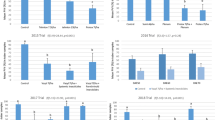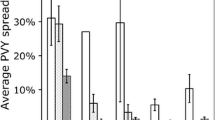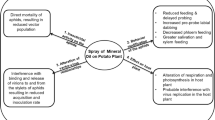Abstract
In the 2014 and 2015 crop seasons, the efficacies of different types, rates and combinations of mineral oil and insecticide foliar sprays for reducing Potato virus Y (PVY) spread were tested in controlled field trials in New Brunswick (NB), Canada. Experimental plots were planted with certified PVY-free Goldrush, supplemented with known virus-infected seed to raise PVY inoculum to 2.3% and 3% at the beginning of the 2014 and 2015 seasons, respectively. Treatments consisted of mineral oil-only sprays at different application rates, insecticide-only sprays of differing numbers, and several combined mineral oil and insecticide spray regimes, all compared to a no-spray control treatment. PVY spread to 18% (2014) and 22% (2015) of initially virus-free plants in no-spray control plots, with significant reductions observed in PVY spread in several treatments. Greatest PVY reductions, as low as 4% (2014) and 12% (2015), were in combined mineral oil and insecticide spray treatments, followed by oil-only sprays; while insecticide-only sprays did not significantly reduce PVY spread. As well as measuring PVY spread to marked test plants and randomly collected post-harvest tuber sample from the plots, exhibited similar treatment pattern for PVY incidence. Multiple logistic regression modeling confirmed the relative efficacy of combined oil and insecticide sprays for reducing PVY spread, while accounting for variable inoculum and aphid factors. Modeling also highlighted the importance of planting low-PVY seed initially, and of early application of foliar sprays. Local best management practice recommendations for reduction of in-field PVY spread were discussed.
Resumen
En los ciclos de cultivo de 2014 y 2015, se probaron, en ensayos controlados de campo en New Brunswick, Canadá, las eficacias de diferentes tipos, dosis, y combinaciones de aceite mineral e insecticidas en aspersión foliar, para reducir la dispersión del virus Y de la papa (PVY). Los lotes experimentales se plantaron con semilla certificada libre de PVY, var. Goldrush, suplementada con semilla infectada de virus para aumentar el inóculo de PVY a 2.3% y 3% al principio de los ciclos de 2014 y 2015, respectivamente. Los tratamientos consistieron de aspersiones solamente con aceite mineral en diferentes dosis, o solamente de diferente número de insecticidas, y de varias combinaciones de regímenes de aspersiones de aceite mineral e insecticidas, todos comparados con un tratamiento testigo sin aspersiones. El PVY se dispersó al 18% (2014) y 22% (2015) de plantas inicialmente libres de virus en los lotes testigo sin aspersiones, con reducciones significativas observadas en la dispersión de PVY en varios tratamientos. Las reducciones mayores de PVY, de hasta 4% (2014) y 12% (2015), fueron en los tratamientos de aspersiones de combinaciones de aceite mineral e insecticida, seguidos de las hechas solamente con aceite, mientras que las de únicamente insecticida no redujeron significativamente la dispersión. Así como al medir la dispersión del PVY a plantas marcadas y colecta al azar de muestras de tubérculo en post-cosecha, se exhibieron patrones similares de tratamiento para la incidencia de PVY. Los modelos de regresión múltiple confirmaron la eficacia relativa de la aspersión con la combinación de aceite e insecticida para reducir la dispersión del PVY, mientras se contaba con los factores de las variables de inóculo y de áfidos. Al modelar, también resaltó la importancia de plantar inicialmente semilla baja en PVY, y de la aplicación temprana de aspersiones foliares. Se discutieron las mejores recomendaciones locales sobre prácticas de manejo para la reducción de la dispersión de PVY en el campo.




Similar content being viewed by others
References
Al-Mrabeh, A., Anderson E., Torrance, L., Evans, A. and Fenton B. 2010. A literature review of insecticide and mineral oil use in preventing the spread of non-persistent viruses in potato crops. Agriculture and Horticulture Development Board.
Ameline, A., A. Couty, M. Martoub, and P. Giordanengo. 2009. Effects of mineral oil application on the orientation and feeding behaviour of Macrosiphum euphorbiae (Homoptera: Aphidae). Acta Entomologica Sinica 52: 617–623.
Boquel, S., M. Giguère, C. Clark, U. Nanayakkara, J. Zhang, and Y. Pelletier. 2013. Effect of mineral oil on Potato virus Y acquisition by Rhopalosiphum padi. Entomologia Experimentalis et Applicata 148: 48–55.
Boquel, S., J. Zhang, C. Goyer, M.-A. Giguère, C. Clark, and Y. Pelletier. 2015. Effect of insecticide-treated potato plants on aphid behavior and Potato Virus Y acquisition. Pest Management Science 71: 1106–1112.
Bradley, R.H.E., C.A. Moore, and D.D. Pond. 1966. Spread of Potato Virus Y curtailed by oil. Nature 209: 1370–1371.
Cervantes, F.A., and J.M. Alvarez. 2008. Role of hairy nightshade Solanum sarrachoides (Sendtner) in the transmission of Potato virus Y (PVY) strains by aphids and study of different PVY strains reaction on Solanum tuberosum (Linnaeus). Phytopathology 98: S190–S190.
Crosslin, J.M. 2013. PVY: an old enemy and a continuing challenge. American Journal of Potato Research 90(1): 2–6.
Davidson, R.D., A.J. Houser, K. Sather, and R. Haslar. 2013. Controlling PVY in seed: what works and what does not. American Journal of Potato Research 90: 28–32.
Döring, T.F. 2011. Potential and limitations of plant virus epidemiology: lessons from the Potato virus Y Pathosystem. Potato Research 54: 341–354.
Dupuis, B., R. Schwaerzel, and J. Derron. 2014. Efficacy of three strategies based on insecticide, oil and elicitor treatments in controlling aphid populations and Potato Virus Y epidemics in potato fields. Journal of Phytopathology 162: 14–18.
Fageria, M.S., M. Singh, U. Nanayakkara, Y. Pelletier, X. Nie, and D. Wattie. 2013. Monitoring current season spread of Potato Virus Y in potato fields using ELISA and real-time RT-PCR. Plant Disease 97: 641–644.
Fenton, B., W.T. Salter, G. Malloch, G. Begg, and E. Anderson. 2015. Stopped in its tracks: how λ-cyhalothrin can break the aphid transmission of a potato potyvirus. Pest Management Science 71: 1611–1616.
Fereres, A., and A. Moreno. 2009. Behavioural aspects influencing plant virus transmission by homopteran insects. Virus Research 141: 158–168.
Gibson, R.W., and A.D. Rice. 1986. The combined use of mineral oils and pyrethroids to control plant viruses transmitted non- and semi-persistently by Myzus persicae. Annals of Applied Biology 109: 467–472.
Gibson, R.W., A.D. Rice, and R.M. Sawicki. 1982. Effects of the pyrethroid deltamethrin on the acquisition and inoculation of viruses by Myzus persicae. Annals of Applied Biology 100: 49–54.
Gray, S., S. De Boer, J. Lorenzen, A. Karasev, J. Whitworth, P. Nolte, R. Singh, A. Boucher, and H. Xu. 2010. Potato virus Y: an evolving concern for potato crops in the United States and Canada. Plant Disease 94: 1384–1397.
Hansen, L.M., and S.L. Nielsen. 2012. Efficacy of mineral oil combined with insecticides for the control of aphid virus vectors to reduce Potato Virus Y infections in seed potatoes (Solanum tuberosum). Acta Agriculturae Scandinavica Section B Soil and Plant Science 62: 132–137.
Heinbach, U., T. Thierne, H.L. Weidemann, and R. Thienne. 1998. Transmission of potato virus Y by aphid species which do not colonise potatoes. In Aphids in natural and managed ecosystems, ed. J.M. Nieto Nafria and A.F.G. Dixon, 555–559. Leon: Universidad de Leon.
Kirchner, S.M., T.F. Doering, L.H. Hiltunen, E. Virtanen, and J.P.T. Valkonen. 2011. Information-theory-based model selection for determining the main vector and period of transmission of Potato Virus Y. Annals of Applied Biology 159: 414–427.
Loebenstein, G., and B. Raccah. 1980. Control of non-persistently transmitted aphid-borne viruses. Phytoparasitica 8: 221–235.
MacKenzie, T.D.B., M.S. Fageria, X. Nie, and M. Singh. 2014. Effects of crop management practices on current-season spread of Potato Virus Y. Plant Disease 98: 213–222.
MacKenzie, T.D.B., X. Nie, and M. Singh. 2016. Crop management practices and reduction of on-farm spread of Potato virus Y: a 5-year study in commercial potato fields in New Brunswick, Canada. American Journal of Potato Research. doi:10.1007/s12230-016-9534-4.
Morita, M., T. Ueda, T. Yoneda, T. Koyanagi, and T. Haga. 2007. Flonicamid, a novel insecticide with a rapid inhibitory effect on aphid feeding. Pest Management Science 63: 969–973.
Pelletier, Y., X. Nie, M. Giguere, U. Nanayakkara, E. Maw, and R. Foottit. 2012. A new approach for the identification of aphid vectors (Hemiptera: Aphididae) of potato virus Y. Journal of Economic Entomology 105: 1909–1914.
Perring, T.M., N.M. Gruenhagen, and C.A. Farrar. 1999. Management of plant viral diseases through chemical control of insect vectors. Annual Review of Entomology 44: 457–481.
R Development Core Team. 2008. R: A language and environment for statistical computing. R Foundation for Statistical Computing, Vienna, Austria. http://www.R-project.org.
Sigvald, R. 1987. Aphid migration and the importance of some aphid species as vectors of Potato-Virus Y O (PVYO) in Sweden. Potato Research 30: 267–283.
Singh, R.P., D.L. McLaren, X. Nie, and M. Singh. 2003. Possible escape of a recombinant isolate of Potato virus Y by serological indexing and methods of its detection. Plant Disease 87: 679–685.
Steinger, T., H. Gilliand, and T. Hebeisen. 2014. Epidemiological analysis of risk factors for the spread of potato viruses in Switzerland. Annals of Applied Biology 164: 200–207.
Steinger, T., G. Goy, H. Gilliand, T. Hebeisen, and J. Derron. 2015. Forecasting virus disease in seed potatoes using flight activity data of aphid vectors. Annals of Applied Biology 166: 410–419.
Wróbel, S. 2009. The retention of PVY in the stylet of Myzus persicae Sulz. After the application of mineral oil on potato plants. Plant Breed Seed Science 60: 3–12.
Wróbel, S. 2014. Efficacy of mineral oil-insecticide mixtures for protection of potato tubers against PVY and PVM. American Journal of Potato Research 91: 706–713.
Acknowledgements
The authors thank Canada/New Brunswick Embracing Innovation in Agriculture and Agri-Food Program, and the Canadian Horticultural Council - Cluster 2 for funding. Additionally, Angela Gallagher, Megan Hampsey, Julia Carpenter and other staff of ACS Inc., and Janet McLaughlin and Mitchell Smith and other staff of NBDAAF for their help in field operations and laboratory sample processing.
Author information
Authors and Affiliations
Corresponding author
Rights and permissions
About this article
Cite this article
MacKenzie, T.D.B., Lavoie, J., Nie, X. et al. Effectiveness of Combined Use of Mineral Oil and Insecticide Spray in Reducing Potato Virus Y (PVY) Spread under Field Conditions in New Brunswick, Canada. Am. J. Potato Res. 94, 70–80 (2017). https://doi.org/10.1007/s12230-016-9550-4
Published:
Issue Date:
DOI: https://doi.org/10.1007/s12230-016-9550-4




